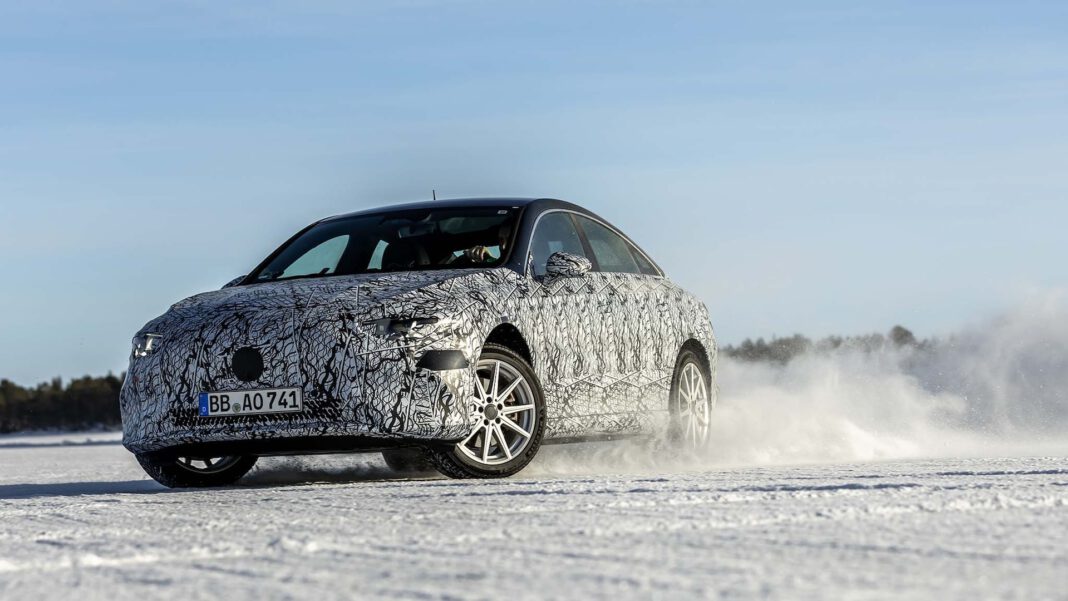The 2026 Mercedes-Benz CLA is the latest in a spate of new vehicles reversing the technology trickle-down process we normally see from the three-pointed star. In the past, Benz’s latest and greatest technologies would debut on the S-Class limousine before making their way to more affordable models. The new CLA sedan plays the same entry-level role in the Mercedes-Benz lineup it has for years, but it will launch new-to-the-brand toys that, eventually, will appear in the next-generation S-Class, including the new MB.OS operating system, bigger and brighter screens, and a new brake control system. The new CLA is available with a 48-volt mild-hybrid powertrain anchored by a new 1.5-liter four-cylinder engine. But it was primarily designed to be first of Mercedes-Benz’s second-generation EVs, with those all-electric versions getting an 800-volt electrical architecture, e-motors developed in-house, and a new battery chemistry.
This new CLA the most sophisticated compact car Mercedes-Benz has ever built, the three-pointed star’s first truly software defined vehicle.
The CLA is built on Mercedes-Benz’s new MMA vehicle architecture, which will ultimately also underpin a swoopy Shooting Brake version of the CLA as well as the next-generation GLA and GLB compact SUVs. It has been designed from the outset to accommodate both battery electric and internal combustion engine powertrains. “We said the market wouldn’t be there for electric vehicles in this segment in 2025, so MMA is based on the idea of EV first, not EV only,” says Christoph Starzynski, head of product strategy at Mercedes-Benz.
The CLA was thus originally designed as an EV and then adapted to accommodate an internal combustion engine powertrain. Both versions look virtually identical inside and out and will be built on the same assembly line in Rastatt, Germany, but have different floorpans and unique front and rear body structures under the sheet metal to handle different crash performance requirements. “We had to work harder to do the internal combustion engine model than we normally would have,” says Axel Heix, chief engineer, compact cars for Mercedes-Benz. “It was an expensive project,” he concedes, “but it would have been more expensive to do two separate cars.” There’s another upside: Mercedes can flex the production of EV or ICE models in accordance with market demand.
The 48-volt mild-hybrid CLA will almost certainly be the volume selling model when the car goes on sale in the U.S. later this year. The base CLA hybrid will be front-wheel drive, but an all-wheel drive 4Matic version will also be available. The heart of its all-new powertrain is the 1.5-liter four-cylinder engine mounted transversely between the front wheels. Dubbed the M252, the engine features an all-aluminum block, a cylinder head with partially integrated manifold, and a turbocharger with a segmented turbine and switchable scroll connection to improve low-end torque. It features Miller cycle combustion technology with a 12.5:1 compression ratio to improve fuel efficiency under partial throttle.
The engine develops 188 hp and drives through a new eight-speed dual-clutch transmission with a fully integrated electric motor fed by a 1.3-kWh lithium-ion battery—that contributes an additional 27 hp and 59 lb-ft of torque to help with torque fill as the transmission works through ratios that are widely spaced to improve fuel efficiency. The transmission’s clutches are electro-hydraulically controlled, allowing the hybrid CLA to be driven short distances on pure electric power and to enable the e-motor to support fuel-saving coasting at speeds up to 62 mph. The system also allows the transmission to recoup as much as 25 kW of electrical energy in all eight gears, and for the e-motor to be used to start the internal combustion engine, eliminating the need for a conventional starter motor.
The electric-powered CLA deploys engineering learnings from the futuristic EQXX concept that has set records for electric vehicle range and speed. In the U.S. the base EV powertrain will comprise a 148-hp rear-mounted e-motor with two-speed transmission that enables a 130 mph top speed. It’s powered by an 85 kWh battery that features silicon carbide anodes and 20 percent better energy density. Mercedes engineers say this version of the electric powered CLA will deliver an impressive WLTP-rated range of more than 466 miles, and as it can accept charge rates of up to 320 kW, 186 miles of range can be added in as little 10 minutes on a fast charger.
The electric-powered CLA 4Matic gets an additional 107 hp e-motor at the front axle that pushes the total system output to 349 hp. Despite the extra power, engineers say the range of the electric-powered CLA 4Matic, which also gets the 85 kWh battery, won’t be that much less than that of the rear-drive model because the front e-motor decouples from the front axle when not needed for power or regenerative braking. And though Benz officials have yet to confirm its existence, there will be AMG version of the new CLA, and it will be electric only. The car, currently under development at AMG’s headquarters in Affalterbach, is rumored to have a total system output of 536 hp and a top speed of about 150 mph.
We had the opportunity to sample prototypes of both the mild-hybrid 4Matic and EV 4Matic versions of the new CLA at Mercedes-Benz’s winter testing facility outside Arjeplog, Sweden. First impressions: Unlike the current CLA, it doesn’t feel like a car derived from what was originally a hatchback designed to compete with Audi’s A3 and Volkswagen’s Golf. Overall, the new CLA has much of the quietly competent character of a current C-Class sedan, with notably low levels of wind and road noise; a pliant, well-controlled ride; and light yet direct steering. The electric-powered CLA is a staggeringly refined small car, smoother and quieter and quicker than its internal combustion engine sibling: Despite a comprehensive NHV package comprising foams and covers, and double-layered firewall, the little 1.5-liter four-cylinder can get vocal when pushed.
The electric CLA can recoup up to 200 kW during regenerative braking events, its new digital brake control system allowing regeneration to occur even under full ABS braking on icy roads, the system’s software ensuring a confident, consistent pedal feel. Four levels of lift-off regen are available: D Auto, which lets the car’s software optimize the regen levels; D , which allows the car to coast; D, which slows the CLA in much the same way as when lifting off the gas in an internal combustion engine vehicle; and D-, which allows one-pedal driving, and will even bring the car to a halt on an icy downhill. Toggling between the modes is achieved by pushing or pulling the column-mounted shift lever.
The CLA prototypes we drove were fitted with 18-inch wheels with different tire setups. The hybrid rolled on 225/45 tires front and rear, while the EV had a staggered arrangement, with 225/45 tires up front and 255/40 items at the rear. That’s because the EV has a more rearward weight bias than the hybrid and its rear wheels are funnelling much more power and torque to the tarmac. In Sport mode – annoyingly, you must toggle through every mode via a push button to select the one you want –the hybrid 4Matic reacted a touch more sharply to initial steering inputs on the ice handling track at the Mercedes-Benz test center, but the more powerful EV 4Matic’s rear-biased handling made it more fun to drive.
The disguise comes off the all-new Mercedes-Benz CLA in a couple of weeks when the car is officially unveiled in Rome. That’s when we’ll learn more about things such as what the new MB.OS operating system can do and how much of the interior and exterior design previewed by the Concept CLA Class in 2023 has made it into production.







